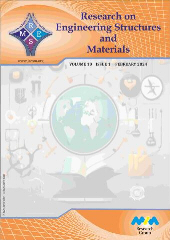Research Article
Analyzing and examining the impact of various fiber types on the mechanical and functional characteristics of UHPC
Mohammad Sadegh Shahid Zadeh, Amir Hossein Derakhshan Nezhad, Mahbobeh Mirzaie Aliabadi
Department of Civil Engineering, Behbahan Khatam Alanbia University of Technology, Behbahan, Iran
Keywords
Abstract
Self-compacting concrete;
Permeability;
Compressive strength;
Tensile strength;
Temperature effect;
Ultrasonic pulse speed
In this research, we compared the performance and mechanical properties of (UHPC) produced with varying percentages of waste and recycled fibers, including polypropylene plastic (plastic sack fibers) (PP), polyethylene terephthalate (PET), date palm fibers (DP), Monterey pine tree fibers (MP), human hair (HH), and aluminum (from metal cans) (AF). This was done in relation to a control sample of UHPC (WC). The study investigated the effects of different percentages of these fibers (0, 0.5, 1, 1.5, and 2 percent by weight of cement) with a length of 3 cm in self-compacting concrete. We conducted tests on fresh concrete, including Slump Flow, J-Ring, V-Funnel, L-Box, and U-Box, as well as tests on hardened concrete, such as compressive strength, tensile strength, permeability, crack width control, thermal cracking, Schmidt hammer tests, and ultrasonic pulse velocity. The results indicated that increasing the percentage of fibers (PP, PET, DP, AF, MP, and HH) in UHPC enhances tensile strength, reduces permeability, and increases compressive strength. Additionally, under the influence of temperature, a decrease in both the depth and length of cracks was observed in the concrete slabs. Notably, the inclusion of 2% human hair fibers (HH) in UHPC resulted in superior tensile strength, reduced permeability, and minimized both the length and depth of cracks compared to other fiber types. Conversely, the addition of 2% aluminum fibers (AF) led to a reduction in tensile strength, an increase in permeability, and an increase in both the length and depth of cracks. This research demonstrated that, in terms of mechanical and functional properties, human hair fibers provided better results in UHPC across all tests conducted, significantly enhancing the longevity of the structure.
© 2024 MIM Research Group. All rights reserved.

